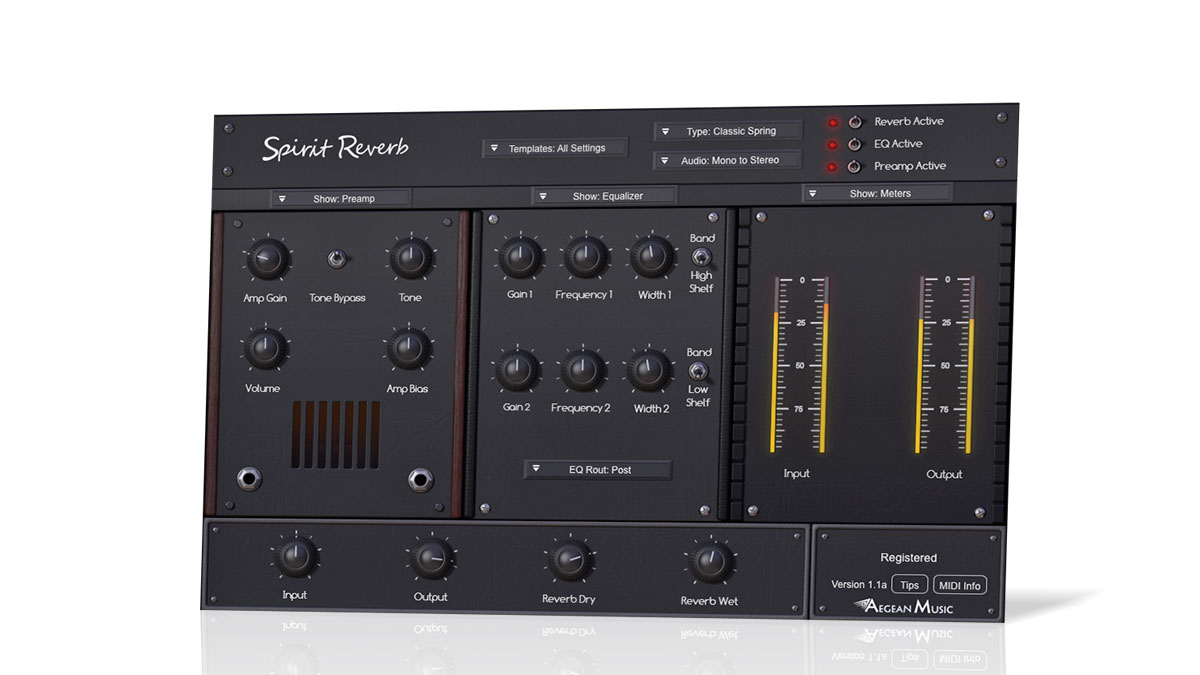MusicRadar Verdict
Spirit Reverb does a very good job of delivering a range of spring reverb sounds, but the interface is a bit odd, and it desperately needs a proper manual.
Pros
- +
Authentic sound. Interesting routing options. A good variety of reverb types. Affordable.
Cons
- -
Confusing interface. No documentation.
MusicRadar's got your back
There's something quaint and even comforting about the familiar drippy 'boing' of spring reverb and, like all things old, it's undergoing something of a renaissance. Aegean Music knows it and has created Spirit Reverb to recreate that gloriously lo-fi effect.
Spirit Reverb (VST/AU) is presented in a large and - it has to be said - potentially confusing interface. The top section sports a trio of dropdown menus. Front and centre is one that allows you to choose from a bare handful of preset "templates" to quickly get up and running without much tweaking.
"The sound of Spirit Reverb is quite authentic, e.g. giving drum machine tracks that subterranean feel so popular in the 80s"
Classic-style setups like Vintage Spring, Small Spring, Dark Spring and Dark Digital sound good on their own, but also make fine jumping off points for your own patches. There's no indication as to which template is currently selected, though - the read-out always says "Templates: All Settings".
The second menu is used to select the type of reverb used. There are seven choices, the first six of which are Classic Spring, Bright Spring, Exaggerated, Low Exaggerated, Echoing, and Cosmic.
The first two of these make the familiar guitar amp-style spring reverb sound, while the others represent more extreme variations on the theme. The seventh type, Digital, is an emulation of a digital spring reverb patch.
At the bottom are controls for input and output levels, dry and wet reverb levels, as well as buttons for calling up a (basic) tips page and a list of MIDI CC assignments - the only documentation available. A manual would be most welcome.
Three out of five ain't bad The bulk of the GUI is occupied by three modules, each displaying one of five selectable sections: Preamp, EQ, Reverb, Springs and Meters.
These aren't actually interchangeable modules but merely displays for viewing three of Spirit Reverb's five processing/metering sections in a wholly arbitrary arrangement - ie, they have no bearing on routing. Why we're not permitted to view all five at once, we're not sure.
The EQ, however, can be placed either at the very end of the chain, or after the wet reverb output. Its two bands are switchable between parametric and shelving - one high, the other low, each with a frequency range of 1-20,000Hz.
Basic filtering can be done with the Preamp section's Tone control - high-pass for most of its range, with a bit of low-pass, too, at the lowest setting - and considerable boost is available via its Gain and Volume knobs.
The preamp delivers a pretty decent tube amp emulation, imparting a rounded, mildly distorted tone that can be pushed into serious crunch. On its own, it's not terribly exciting, but it makes a worthy companion to the reverb, warming it up nicely.
In the Springs panel, you choose the number of springs used (up to three), and tweak their length, while the Reverb panel contains controls for pre-delay, reverb time, high frequency damping, depth and stereo width.
The sound of Spirit Reverb is quite authentic, giving drum machine tracks that subterranean feel so popular in the 80s and absolutely making our Telecaster's surf tone, imparting all of the wet 'splat' of the real thing.
While, like any spring reverb, it wouldn't be our first choice for a slick vocal or drum sound, it's got bags of character - ideal for groovy, vintage vibes. We're not overly enamoured with the GUI, but there's no denying the sound, and if you're a guitarist or old-school dub artist, you'll love it, as will anyone simply looking for a bit of lo-fi, retro cool.
Computer Music magazine is the world’s best selling publication dedicated solely to making great music with your Mac or PC computer. Each issue it brings its lucky readers the best in cutting-edge tutorials, need-to-know, expert software reviews and even all the tools you actually need to make great music today, courtesy of our legendary CM Plugin Suite.
“We are so unencumbered and unbothered by these externally imposed rules or other people’s ideas for what music should be”: Blood Incantation on the making of Absolute Elsewhere and how “Data from Star Trek” saved the album – and the studio
“Delivers streamlined DAW integration with an excellent hammer action keyboard”: Arturia Keylab 88 Mk3 review
“I have an original 909 – every time I try to use it I feel like I’m ruining it”: House hero Riva Starr on his studio essentials and his love of analogue synths











